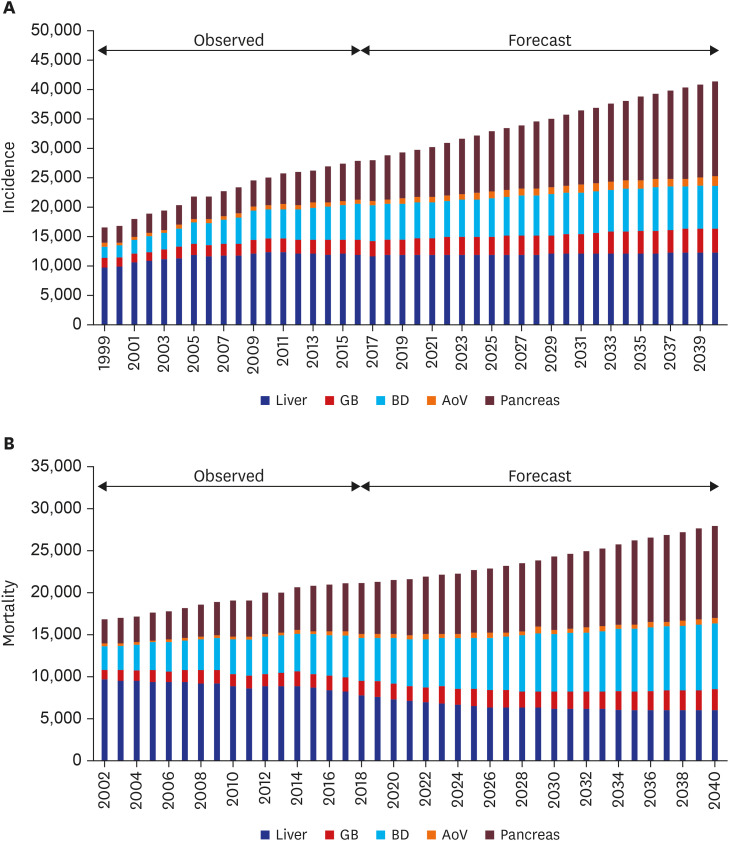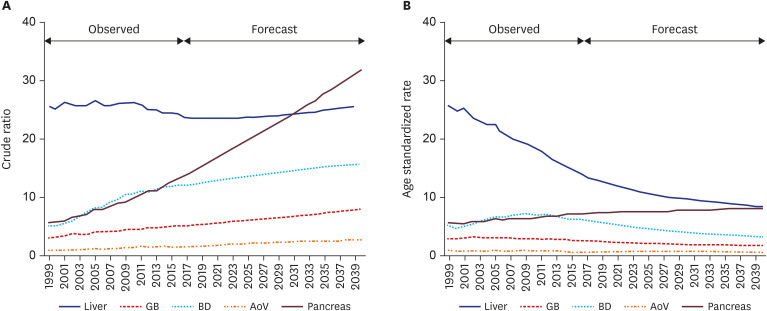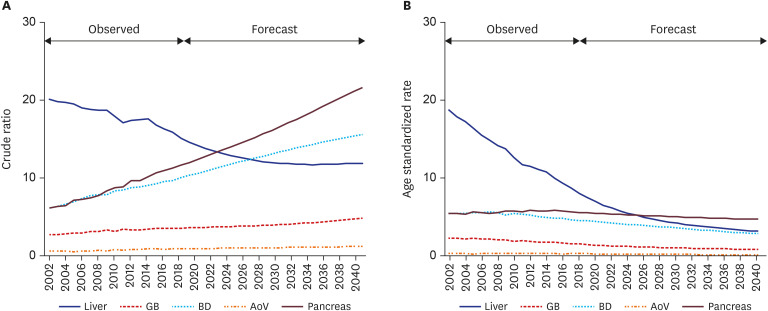J Korean Med Sci.
2022 Jul;37(28):e216. 10.3346/jkms.2022.37.e216.
Trend Analysis and Prediction of Hepatobiliary Pancreatic Cancer Incidence and Mortality in Korea
- Affiliations
-
- 1Center for Liver and Pancreatobiliary Cancer, National Cancer Center, Goyang, Korea
- 2Korea Central Cancer Registry, National Cancer Center, Goyang, Korea
- 3Division of Cancer Registration and Surveillance, National Cancer Control Institute, National Cancer Center, Goyang, Korea
- 4Department of Surgery, Chung-Ang University Gwang-Myeong Hospital, Gwangmyeong, Korea
- KMID: 2531801
- DOI: http://doi.org/10.3346/jkms.2022.37.e216
Abstract
- Background
This study aimed to analyze the current trends and predict the epidemiologic features of hepatobiliary and pancreatic (HBP) cancers according to the Korea Central Cancer Registry to provide insights into health policy.
Methods
Incidence data from 1999 to 2017 and mortality data from 2002 to 2018 were obtained from the Korea National Cancer Incidence Database and Statistics Korea, respectively. The future incidence rate from 2018 to 2040 and mortality rate from 2019 to 2040 of each HBP cancer were predicted using an age-period-cohort model. All analyses, including incidence and mortality, were stratified by sex.
Results
From 1999 to 2017, the age-standardized incidence rate (ASIR) of HBP cancers per 100,000 population had changed (liver, 25.8 to 13.5; gallbladder [GB], 2.9 to 2.6; bile ducts, 5.1 to 5.9; ampulla of Vater [AoV], 0.9 to 0.9; and pancreatic, 5.6 to 7.3). The age-standardized mortality rate (ASMR) per 100,000 population from 2002 to 2018 of each cancer had declined, excluding pancreatic cancer (5.5 to 5.6). The predicted ASIR of pancreatic cancer per 100,000 population from 2018 to 2040 increased (7.5 to 8.2), but that of other cancers decreased. Furthermore, the predicted ASMR per 100,000 population from 2019 to 2040 decreased in all types of cancers: liver (6.5 to 3.2), GB (1.4 to 0.9), bile ducts (4.3 to 2.9), AoV (0.3 to 0.2), and pancreas (5.4 to 4.7). However, in terms of sex, the predicted ASMR of pancreatic cancer per 100,000 population in females increased (3.8 to 4.9).
Conclusion
The annual incidence and mortality cases of HBP cancers are generally predicted to increase. Especially, pancreatic cancer has an increasing incidence and will be the leading cause of cancer-related death among HBP cancers.
Figure
Reference
-
1. Statistics Korea. Updated 2020. Accessed February 8, 2020. http://kosis.kr .2. Hong S, Won YJ, Lee JJ, Jung KW, Kong HJ, Im JS, et al. Cancer statistics in Korea: incidence, mortality, survival, and prevalence in 2018. Cancer Res Treat. 2021; 53(2):301–315. PMID: 33735559.
Article3. Sagnelli E, Macera M, Russo A, Coppola N, Sagnelli C. Epidemiological and etiological variations in hepatocellular carcinoma. Infection. 2020; 48(1):7–17. PMID: 31347138.
Article4. McGlynn KA, Petrick JL, El-Serag HB. Epidemiology of hepatocellular carcinoma. hepatology. Hepatology. 2021; 73(Suppl 1):4–13.5. Yeo Y, Gwack J, Kang S, Koo B, Jung SJ, Dhamala P, et al. Viral hepatitis and liver cancer in Korea: an epidemiological perspective. Asian Pac J Cancer Prev. 2013; 14(11):6227–6231. PMID: 24377509.
Article6. Kim MN, Han KH, Ahn SH. Prevention of hepatocellular carcinoma: beyond hepatitis B vaccination. Semin Oncol. 2015; 42(2):316–328. PMID: 25843736.
Article7. Valle JW, Kelley RK, Nervi B, Oh DY, Zhu AX. Biliary tract cancer. Lancet. 2021; 397(10272):428–444. PMID: 33516341.
Article8. Jung KW, Won YJ, Kong HJ, Lee ES. Prediction of cancer incidence and mortality in Korea, 2019. Cancer Res Treat. 2019; 51(2):431–437. PMID: 30913864.
Article9. Jung KW, Won YJ, Hong S, Kong HJ, Lee ES. Prediction of cancer incidence and mortality in Korea, 2020. Cancer Res Treat. 2020; 52(2):351–358. PMID: 32178488.
Article10. Jung KW, Won YJ, Kong HJ, Lee ES. Cancer statistics in Korea: incidence, mortality, survival, and prevalence in 2016. Cancer Res Treat. 2019; 51(2):417–430. PMID: 30913865.
Article11. Hong S, Won YJ, Park YR, Jung KW, Kong HJ, Lee ES, et al. Cancer statistics in Korea: incidence, mortality, survival, and prevalence in 2017. Cancer Res Treat. 2020; 52(2):335–350. PMID: 32178489.
Article12. Shin HR, Won YJ, Jung KW, Kong HJ, Yim SH, Lee JK, et al. Nationwide cancer incidence in Korea, 1999–2001; first result using the national cancer incidence database. Cancer Res Treat. 2005; 37(6):325–331. PMID: 19956367.
Article13. Fritz AP, Jack A, Shanmugaratnam K, Sobin L, Parkin DM, et al. International Classification of Diseases for Oncology. 3rd ed. 1st rev. Geneva, Switzerland: World Health Organization;2013.14. World Health Organization. International Statistical Classification of Diseases and Related Health Problems. 10th rev. Geneva, Switzerland: World Health Organization;1994.15. Segi M. Cancer Mortality for Selected Sites in 24 Countries (1950–1957). Sendai, Japan: Tohoku University School of Medicine;1960.16. Rosenberg PS, Check DP, Anderson WF. A web tool for age-period-cohort analysis of cancer incidence and mortality rates. Cancer Epidemiol Biomarkers Prev. 2014; 23(11):2296–2302. PMID: 25146089.
Article17. Howlader N, Noone AM, Krapcho M, Garshell J, Neyman N, Altekruse SF, et al. SEER cancer statistics review, 1975–2010. Updated 2013. Accessed September 17, 2013. https://seer.cancer.gov/archive/csr/1975_2010/ .18. Kim HJ, Fay MP, Feuer EJ, Midthune DN. Permutation tests for joinpoint regression with applications to cancer rates. Stat Med. 2000; 19(3):335–351. PMID: 10649300.
Article19. Ferlay J, Colombet M, Soerjomataram I, Dyba T, Randi G, Bettio M, et al. Cancer incidence and mortality patterns in Europe: estimates for 40 countries and 25 major cancers in 2018. Eur J Cancer. 2018; 103:356–387. PMID: 30100160.
Article20. Siegel RL, Miller KD, Jemal A. Cancer statistics, 2020. CA Cancer J Clin. 2020; 70(1):7–30. PMID: 31912902.
Article21. Rahib L, Smith BD, Aizenberg R, Rosenzweig AB, Fleshman JM, Matrisian LM. Projecting cancer incidence and deaths to 2030: the unexpected burden of thyroid, liver, and pancreas cancers in the United States. Cancer Res. 2014; 74(11):2913–2921. PMID: 24840647.
Article22. Jung KW, Won YJ, Hong S, Kong HJ, Im JS, Seo HG. Prediction of Cancer Incidence and Mortality in Korea, 2021. Cancer Res Treat. 2021; 53(2):316–322. PMID: 33735558.
Article23. Spanknebel K, Conlon KC. Advances in the surgical management of pancreatic cancer. Cancer J. 2001; 7(4):312–323. PMID: 11561607.24. Kang MJ, Lim J, Han SS, Park HM, Park SJ, Won YJ, et al. First course of treatment and prognosis of exocrine pancreatic cancer in Korea from 2006 to 2017. Cancer Res Treat. 2022; 54(1):208–217. PMID: 34030432.
Article25. Lee K, Bang K, Yoo C, Hwang I, Jeong JH, Chang HM, et al. Clinical outcomes of second-line chemotherapy after progression on nab-paclitaxel plus gemcitabine in patients with metastatic pancreatic adenocarcinoma. Cancer Res Treat. 2020; 52(1):254–262. PMID: 31291709.
Article26. Srivastava S, Gray JW, Reid BJ, Grad O, Greenwood A, Hawk ET, et al. Translational Research Working Group developmental pathway for biospecimen-based assessment modalities. Clin Cancer Res. 2008; 14(18):5672–5677. PMID: 18794074.
Article27. Kaitin KI. Deconstructing the drug development process: the new face of innovation. Clin Pharmacol Ther. 2010; 87(3):356–361. PMID: 20130565.
Article28. Statistics Korea. Updated 2021. Accessed February 8, 2021. http://kosis.kr .29. McGlynn KA, Petrick JL, London WT. Global epidemiology of hepatocellular carcinoma: an emphasis on demographic and regional variability. Clin Liver Dis. 2015; 19(2):223–238. PMID: 25921660.30. Kim BH, Lim YS, Kim EY, Kong HJ, Won YJ, Han S, et al. Temporal improvement in survival of patients with hepatocellular carcinoma in a hepatitis B virus-endemic population. J Gastroenterol Hepatol. 2018; 33(2):475–483. PMID: 28612951.
Article31. Kim BH, Park JW. Epidemiology of liver cancer in South Korea. Clin Mol Hepatol. 2018; 24(1):1–9. PMID: 29249129.
Article32. Park NH, Chung YH, Lee HS. Impacts of vaccination on hepatitis B viral infections in Korea over a 25-year period. Intervirology. 2010; 53(1):20–28. PMID: 20068337.
Article33. Forner A, Reig M, Bruix J. Hepatocellular carcinoma. Lancet. 2018; 391(10127):1301–1314. PMID: 29307467.
Article34. Villanueva A. Hepatocellular carcinoma. N Engl J Med. 2019; 380(15):1450–1462. PMID: 30970190.
Article35. Kang SH, Cho H, Cho EJ, Lee JH, Yu SJ, Kim YJ, et al. Efficacy of sorafenib for the treatment of post-transplant hepatocellular carcinoma recurrence. J Korean Med Sci. 2018; 33(45):e283. PMID: 30402048.
Article36. Bae SH, Park HC, Yoon WS, Yoon SM, Jung IH, Lee IJ, et al. Treatment outcome after fractionated conformal radiotherapy for hepatocellular carcinoma in patients with Child-Pugh classification B in Korea (KROG 16-05). Cancer Res Treat. 2019; 51(4):1589–1599. PMID: 30971065.
Article




